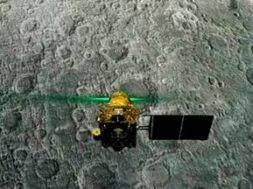
CHACE-2 observes distribution of Argon gas on the Moon’s Exosphere
Bengaluru: According to the Indian Space Research Organisation (ISRO), a quadrupole mass spectrometer onboard Chandrayaan-2 mission called Chandra’s Atmospheric Composition Explorer-2 (CHACE-2) made observations regarding the global distribution of Argon-40 on the Moon’s exosphere.
An exosphere is an outermost region in the upper atmosphere of a celestial body. The natural satellite of Earth consists of a surface-boundary exosphere.
The Bengaluru headquarters stated on Tuesday that the observations provided fresh insights into dynamics on exospheric species and radiogenic activities within the first 10 meters below the lunar surface.
“Various processes like thermal desorption, solar wind sputtering, photo-stimulated desorption, and micro-meteorite impact vaporization on the moon. The exospheric may lose atoms due to thermal escape.”
“Sometimes, the atoms get charged because of photo-ionization and charge exchange with solar wind-ions. Therefore, a convective electric field of the solar wind can sweep the atoms away or deposit them on the lunar surface.”
“Noble gases serve as an important tracer to understand the surface-exosphere interaction of the moon, and Argon (Ar-40) is an important tracer atom to study the dynamics of the lunar exospheric species,” the statement read.
The ISRO claimed that the CHACE-2 observations provided the diurnal and spatial variation of Ar-40 covering the equatorial and mid-latitude regions of the Moon.
The variations in the number density of Ar-40 in mid-latitude regions are similar to that of low latitude regions despite differences in temperature and topography.
“Further, the CHACE-2 observations revealed that the distribution in Ar-40 has significant spatial heterogeneity. There are localized enhancements (termed as Argon bulge) over several regions including the KREEP (potassium (K), rare-earth elements, and phosphorus (P)) and South Pole Aitken terrain.”
“The observations of Argon bulge by CHACE-2 are indicative of unknown or additional loss processes, Moon quakes or regions with lower activation energies, which call for a better understanding of the surface-exosphere interactions and source distributions of Ar-40,” the statement added.
Argon-40 is a noble gas that originated from the disintegration of Potassium-40 (K-40) present below the lunar surface. The gas diffuses through inter-granular space and reaches the lunar exosphere through seepages and faults after being formed.
(Avya Mathur)













